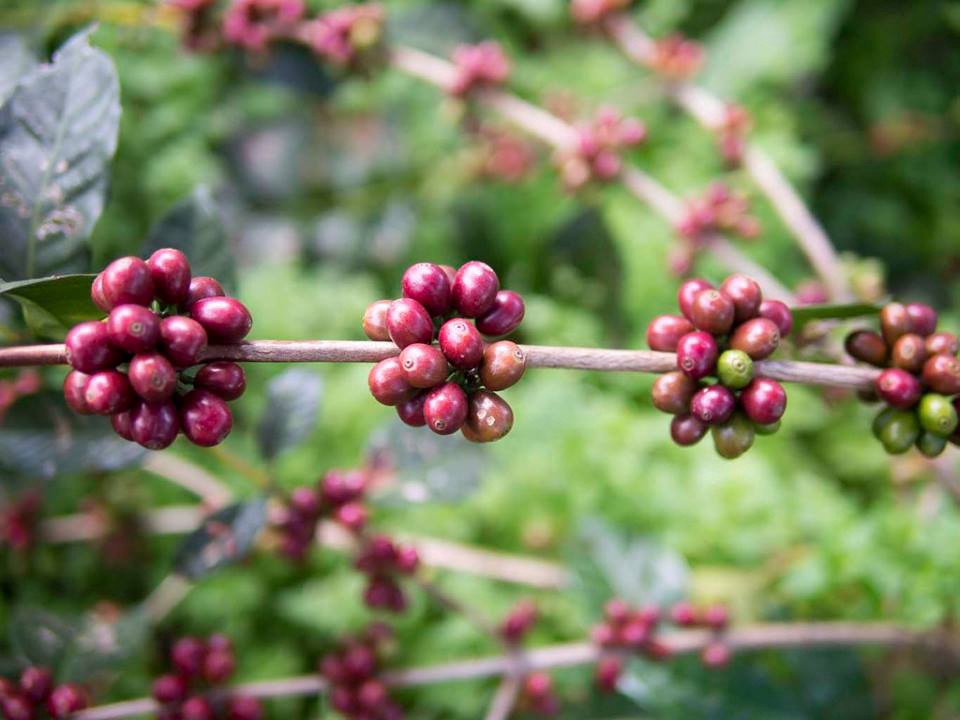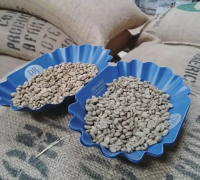How should the planting conditions of coffee trees be planted?
Coffee is one of the three biggest drinks in the world, but do you know how it is grown?
The important condition of coffee cultivation has a noun called "coffee belt".
There are more than 60 coffee producing countries in the world, most of which are located in the tropics and subtropics between the Tropic of Cancer (23 °26 'north and south). This coffee growing area is called "coffee belt (Coffee Belt)" or "coffee zone (Coffee Zone)".
The annual average temperature of the coffee belt is above 20 ℃, because the coffee tree is a tropical plant and cannot grow normally if the temperature is below 20 ℃. 1. Climatic conditions Atobika coffee is not resistant to high temperature and humid climate, nor can it stay at a low temperature below 5 ℃ for a long time, so it is planted on steep slopes at an altitude of 1000-2000 meters above sea level. On the other hand, Robusta coffee is cultivated in lowlands below 1000 meters above sea level because of its strong adaptability (Robusta's original meaning is "tenacious and strong"). Annual average rainfall, rainfall of 1000-2000 mm, coupled with appropriate sunshine, is the most suitable environment for coffee growth. But Arabica coffee is not resistant to strong sunlight and extreme heat, so it is suitable for growing in terrain prone to morning fog, especially where there is a large temperature difference between day and night. In addition, in order to avoid direct sunlight, shelter trees, such as bananas, maize and mango trees, will be planted in working places.
2. To put it simply, the soil suitable for growing coffee is the fertile volcanic soil with enough moisture and moisture and rich in organic matter. The Ethiopian plateau is covered with this kind of volcanic rock weathered soil, so. Soil rich in humus has naturally become one of the basic conditions suitable for growing coffee. In fact, coffee production areas such as the Brazilian highlands (called "Terra rossa", meaning fertile red soil weathered by basalt), the highlands of Central America, the periphery of the South American Andes, the African plateau, the West Indies and Java (some of the soil is also volcanic eolian soil, or a mixture of volcanic ash and humus) are also rich in water-rich soil, just like the Ethiopian plateau. Soil has a subtle effect on the taste of coffee. For example, coffee grown on slightly acidic soil will also have a strong sour taste; for example, the soil around Rio de Janeiro has an iodine flavor, and when picking coffee beans, the fruit will be shaken to the ground by shaking trees, and the coffee will also be contaminated with that unique flavor. 3. Topography and height generally think that the quality of coffee produced in highland is better. Coffee-producing countries in Central America will use "elevation" as the grading standard because there are mountains crossing from the center of the continent. For example, SHB in Guatemala (abbreviated from the prefix Strictly Hard Bean), the highest of the seven grades is called SHB, indicating that its producing area is about 1370 meters above sea level. Although the coffee farm is located on steep slopes and is not convenient for transportation, transportation, cultivation and management, such a terrain has low temperatures and is prone to morning fog, which can ease the strong sunshine peculiar to the tropics and make the coffee fruit mature from time to time. However, premium coffee such as "Blue Mountain" and "Hawaiian Kona" on the island of Jamaica are not harvested in the highlands. Because as long as there is the right temperature, rainfall and soil, there will be morning fog and a large temperature difference between day and night, mountain high-quality coffee can be planted. It can be seen that even if "high real estate equals high quality", it does not mean that "low real estate equals low quality". Elevation can only be regarded as one of the reference criteria for judging the grade of coffee. Although elevation is important, the topography and climatic conditions of the producing area are more important. European countries, the main consumer markets for coffee, have long valued high prices for highland coffee such as Kenya and Colombia. Quantitative coffee beans can extract more coffee liquid (that is, higher concentration), which is one of the reasons why Highland Coffee is well received. In addition, as mentioned earlier, Robusta coffee, which is native to the Congo, is grown in lowlands below 1000 meters above sea level. Unlike Arabica, it grows fast and is resistant to diseases and insect pests, and can be grown in non-fertile soil. Therefore, the taste and aroma are far inferior to Arabica coffee. I don't totally disapprove of Robusta growing coffee, but in principle I don't use Robusta to grow coffee. The reason is actually very simple, but I want to drink higher quality coffee, but also want everyone to enjoy better quality coffee. Daily Management of Coffee planting
The main results are as follows: 1. The root system of intercropping coffee elongates with the growth of plant, and the root growth range is beyond the range of planting hole half a year after planting. Therefore, it is best to dig deeply from half a year to one year before the rainy season comes, and the depth should be 0.4-0.5 meters according to soil conditions and root distribution.
2. To fertilize coffee, we should master the type and amount of fertilizer, not only an appropriate amount, but also to prevent excessive. Insufficient fertilization will lead to yellow leaves, withered shoots, fruit drop, premature senescence and other phenomena; excessive fertilization will not only cause waste, but also worsen the soil. Young coffee tree is a vegetative growth period, fertilization should be mainly nitrogen and phosphorus fertilizer, proper application of potassium fertilizer to promote root and branch growth, accelerate the formation of crown, cultivate good tree type, lay the foundation for high yield, but fertilization should grasp the principle of frequent application and thin application. The fertilization of coffee trees should be based on nitrogen and potassium fertilizer, combined with phosphate fertilizer and other element fertilizer. The scheme of fertilization is as follows: 20 grams of urea per tree for the first time 20 days after survival, and 30 grams of mixed fertilizer of nitrogen, phosphorus and potassium before the end of rainy season. In the second year, the first fertilization was from February to March, the second from May to June, and the third from August to September, with 100 grams of nitrogen, phosphorus and potassium mixed fertilizer per plant each time. In the third year, fertilization was combined with weeding from February to March for the first time, and oil was applied 1000 grams per plant, the second time was from May to June, and the third time was from August to September. Fertilization of coffee trees: the first time from February to March was topdressing 1500 g per plant, and the second, third and fourth times were in May, July and September, respectively. The fertilization method of coffee trees: young trees are 0. 5% off the root base. At 20 meters, the adult tree is digging a ring or semi-ring fertilizer ditch at the dripping point of the plant crown, 0. 5% wide. 20 meters, 0.20-0.30 meters deep, and cover the soil immediately after fertilization. High-yield period
Coffee trees generally blossom in 3-4 years, about 2-3 months a year. The appearance and smell of coffee trees are similar to those of jasmine flowers. After the flowers bloom, they bear small green fruits, which ripen and turn red into ripe fruits that can be picked after a few months.
The skin of ripe fruit is red. Because its shape and color are similar to cherries, ripe coffee fruit is called coffe cherry in many places. Under the bright red pericarp, the peel, pulp and a sweet sticky yellow substance wrap the coffee beans.
Properly manage coffee industry exchanges for about 30 years, please add privacy.
Fragrance of boutique coffee on Wechat, WeChat account:
(long press copy)
Thinkingcapacity

Important Notice :
前街咖啡 FrontStreet Coffee has moved to new addredd:
FrontStreet Coffee Address: 315,Donghua East Road,GuangZhou
Tel:020 38364473
- Prev

What exactly is Ninety Plus coffee90+ coffee?
Professional coffee knowledge exchange more coffee bean information please follow the coffee workshop (Wechat official account cafe_style) friends who like to drink individual coffee, of course, are no strangers to Yega Xuefei, geisha or Manning. But when it comes to the raw coffee beans of Ninety Plus (90 +), many coffee lovers always feel that they are wearing a mysterious veil. In 2006, Joseph Brodsky founded N
- Next

What is the taste often mentioned in coffee?
Taste is a flavor that we experience through touch. The hand is the most sensitive part of the body, followed by the lips and tongue. Our mouths are covered with nerve endings that respond to the density, viscosity, cold and heat of food and drink. The unique tactile feeling of coffee is usually an important factor in determining its quality, that is, the mellow thickness and astringency of coffee. Taste is tactile.
Related
- Beginners will see the "Coffee pull flower" guide!
- What is the difference between ice blog purified milk and ordinary milk coffee?
- Why is the Philippines the largest producer of crops in Liberia?
- For coffee extraction, should the fine powder be retained?
- How does extracted espresso fill pressed powder? How much strength does it take to press the powder?
- How to make jasmine cold extract coffee? Is the jasmine + latte good?
- Will this little toy really make the coffee taste better? How does Lily Drip affect coffee extraction?
- Will the action of slapping the filter cup also affect coffee extraction?
- What's the difference between powder-to-water ratio and powder-to-liquid ratio?
- What is the Ethiopian local species? What does it have to do with Heirloom native species?

